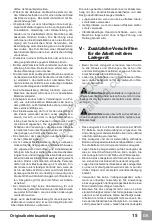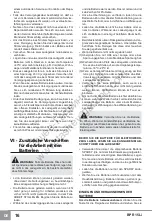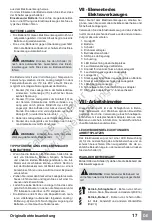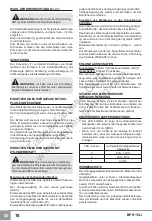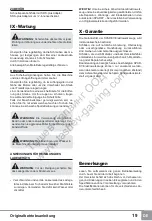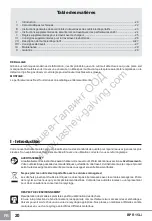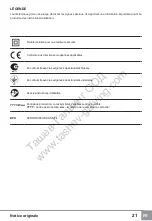
6
BPR 15Li
EN
▪
Damage to the palms and nands due to vibration in
case the machine is operated for a prolonged period
and is not guided and held properly.
V - Additional instructions
for work with the charger
▪
Before using the charger, read all the instructions and
cautionary markings on the charger and battery pack
as well as the instructions on using the battery pack.
▪
Only charge your batteries indoors as the charger is
designed for indoor use only.
WARNING:
If the battery pack is cracked or
damaged in any other way, do not insert it in the char-
ger. There is a danger of electric shock.
WARNING:
Do not allow any liquid to come
into contact with the charger. There is a danger of
electric shock.
▪
The charger is not intended for any use other than
charging the exact type of SPARKY rechargeable
battery as supplied with the machine. Any other use
may result in the risk of fire or electric shock.
▪
The charger and battery packs supplied with it are
specifically designed to work together. Do not attempt
to charge the battery pack with any other charger than
the one supplied.
▪
Do not place any object on top of the charger as it
could cause overheating. Do not place the charger
near any heat source.
▪
Do not pull on the lead of the charger to disconnect it
from the power source.
▪
Make sure that the charger cord is positioned where it
will not be stepped on, tripped over or otherwise sub-
jected to damage or stress.
▪
Do not use an extension cord unless it is absolutely
necessary. The use of an improper extension cord
could cause the risk of fire or electric shock.
▪
Do not use the charger if it has been subjected to a
heavy knock, dropped or otherwise damaged in any
way. Do not operate charger with damaged cord or
plug - have them replaced immediately. Take the
charger to an authorised service centre for a check
or repair.
▪
If the replacement of the supply cord is necessary, this
has to be done by the manufacturer or his agent in
order to avoid a safety hazard.
▪
Do not disassemble the charger. Take it to an author-
ised service centre when service or repair is required.
Incorrect re-assembly may result in the risk of fire or
electric shock.
▪
To reduce the risk of an electric shock, unplug the
charger from the power supply before attempting to
clean it. Removing the battery alone does not reduce
the risk.
▪
Never attempt to connect two chargers together.
▪
Do not store or use the tool and battery pack in lo-
cations where the temperature may reach or exceed
+40°C such as alongside sheds, trailers or metal
structures during summer.
▪
The charger is designed for use from a standard
household electrical supply 230. Do not attempt to
connect the charger to a supply with a different sup-
ply.
▪
If you wish to charge a second battery pack, unplug
the charger from the mains supply and leave it for at
least 15 minutes. After this time you can charge a sec-
ond battery pack.
▪
Under certain conditions, with the charger plugged in
to the power supply, the exposed charging contacts
inside the charger can be shorted by foreign material.
Foreign materials of a conductive nature such as, but
not limited to, steel wool, aluminium foil, or any build-
up of metallic particles should be kept away from
charger cavities. Always unplug the charger from the
power supply when there is no battery pack in the cav-
ity. Unplug charger before attempting to clean.
▪
Do not freeze or immerse charger in water or any
other liquid.
VI - Additional instructions
for work with the
battery pack
WARNING:
If the battery pack is cracked or
damaged in any other way, do not insert it in the char-
ger. There is a danger of electric shock.
▪
Li-Ion batteries can be charged at any time and this
does not reduce their service life. Interrupting the
charging procedure does not damage the battery.
▪
The battery pack should be recharged when it fails to
produce sufficient power on jobs, which were easily
done previously. DO NOT CONTINUE to use under
these conditions. Follow the charging procedure.
▪
The charger and battery pack may become warm to
touch while charging. This is a normal condition, and
does not indicate a problem.
▪
To prevent overheating, do not charge battery packs
in direct sunlight in hot weather or near heat sources.
▪
Do not charge inside a box or container of any kind.
The battery must be placed in a well ventilated area
during charging.
▪
When the battery is defective, liquid can escape and
come into contact with adjacent components. Check
any parts concerned. Clean such parts or replace
them, if required.
▪
If the battery pack does not charge properly:
(1) Check current at receptacle by plugging in a lamp or
other appliance.
(2) Move charger and battery pack to a location where
the surrounding air temperature is approximately 0°C
- 40°C.
(3) If charging problems persist, take or send the tool,
battery pack and charger to your local service centre.
Та
ше
в
-
Га
лв
ин
г
ОО
Д
www.tashev-galving.com

















